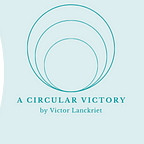A Circular Victory
In this new series of blogs, I will explain what the Circular Economy is. I will initially do so by looking at research I did for my thesis on the Circular Economy. Over time, I will broaden the topics and move away from what I have researched already. This will allow me to discover new ideas, concepts and business examples along with you, my audience.
My aim is to explain the theories and concepts in a way that is easy to grasp. I will also provide examples of Circular Economy that have lead to me being so enthusiastic and passionate about this concept. I sincerely hope that they can do the same for you.
A bit of history: the linear economy
Let’s start with some history. In the Industrial Revolution, we saw unprecedented technical developments. Machinery and factories became commonplace and production and prosperity (and consumption) boomed. To keep up with these changes, the world largely adopted the linear model that we all know now. In a linear economy, we see the concept of “take, make, dispose”. Raw materials are sourced (or “taken”) from the earth. We then transform those raw materials into a product (or “make” them). At the end of the product’s life, we throw it away (or “dispose” it). We can imagine this concept as a line.
This linear model has its obvious limitations. The most important one is the fact that resources on earth are finite. This means that if we just keep wasting raw materials, we will one day run out of them. There will be no more metal in the ground, no more water in the rivers and no more clean air to breathe. We are already starting to see the effects of this. Droughts are an increasingly common problem and manufacturing companies have to pay more and more for raw materials, for example.
How do we solve this? Many of the existing sustainability models rely on using less raw materials or using different raw materials. However, these other raw materials are also finite. These models can certainly postpone the problem, but they won’t solve it. We will still have to deal with resource scarcity at one point or another, so we need to decouple economic growth from the production of waste. This is where the Circular Economy comes in.
The Circular Economy as a solution
The Circular Economy does not advocate for less consumption and less production. Circularity can coexist with a pursuit of profits and a good quality of life. The Circular Economy is a solution that will allow billions of people to emerge from poverty without fatally increasing pollution and waste that our planet cannot deal with.
How is this possible? We aim to stop creating waste. This doesn’t mean that that products need to be used forever or that we don’t throw anything away anymore. What it means is that a product at the end of its life cycle will be reused and recycled to create new products. In doing so, the linear model becomes a Circular one. Where a linear model stops when waste is produced, the Circular model is designed such that waste from one product becomes a resource for another. In doing so, we aim to replicate the cycles that we find in nature. Dead leaves are nutrients for new plants; water evaporates, forms clouds and comes back as rain. Once you start looking for it, nature is full of cycles that are sustainable and designed to last forever. By adopting these same concepts in our world, we can save our earth!
More information on how we can do this and the concepts that support it will be available in my next blog post!
P.S.: Here is the link to the trailer of my podcast!
https://open.spotify.com/episode/3wUa94x0FkE0QLTZwxiggH?si=YfbGbpC2RLKsb9vcKONUPw
